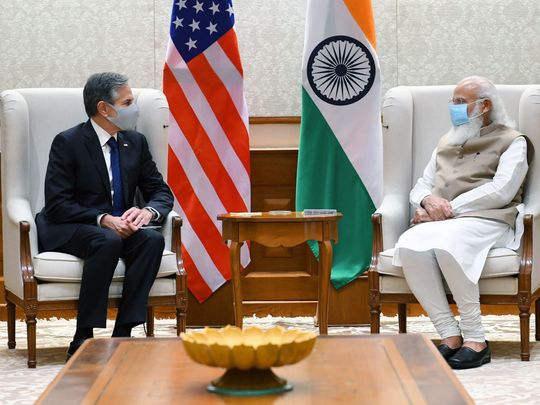
“The Quad grouping is not on military lines, but like-minded democracies coming together on crucial issues of vaccine, climate change, and maritime security,” Antony Blinken said on his first visit to India after taking as United States Secretary of State.
Blinken met several important leaders including the Prime Minister Narendra Modi, External Affairs Minister S Jaishankar and National Security Advisor, Ajit Doval.
The visit assumes significance for a variety of reasons. Not only for the matters discussed including Indo-US vaccine cooperation, Afghanistan, trade and defence, but, also strengthening the ties between the US, Japan, Australia, and India, more famously known as the quad. Importantly, Blinken set the stage for further strengthening of Indo-US relations, especially after the US ambassador-designate to India, Eric Garcetti, assumes office.
Blinken’s visit to India was part of the Joe Biden administration’s wider regional outreach including visits and engagements with Afghanistan, Pakistan, Saudi Arabia, Iran, Israel, Palestine and Kuwait. The world would be relieved at the balanced and sagacious turn of US foreign policy after the somewhat erratic and turbulent rhetoric of Biden’s predecessor, Donald Trump.
Consistency of vision
Biden has shown consistency of vision and willingness to compromise, when it comes to the US’s role in the emerging multipolar world order. Characterised by consensus-building rather than muscle-flexing dominance, the US is now taking the middle, not the high, road.
It is not as if overnight the US is going to relinquish its role as the leader of the free world, but such a position will now be moderated by the growing power of its arch-rival China.
The world will thus see the US increasingly amenable to working with a whole host of partners in order to secure world peace and the rule of law. Neither the US, nor China wants a new Cold War, but each is aware that new blocs and alliances will determine how nations share power in the near future. Broadly speaking, both sides will articulate how their competing and contrasting world visions are better for those in their respective spheres of influence.
In this regard, India is too large and significant to be any other power’s client state. It will have to forge its own, unique path in the world with a combination of economic, strategic, and cultural capabilities. Good relations with the US and China, despite recent border skirmishes with the latter, are therefore imperative.
We must not also forget that India has been Russia’s traditional partner and still imports some 50% of its weaponry from that country. Balancing these past affiliations along with future prospects is thus an ongoing challenge.
What this really means is that sudden changes or surprises in the Indo-US relationship are unlikely. Those who had hoped for a significant uptick or ratcheting-up will have to wait for the Biden-Modi summit planned for later. Progress, in the meanwhile, has to be slow and steady.
Gradualism in international relations is preferable to sudden changes or sharp turns. That long-term solidarity in Indo-US relations makes good sense is all too evident. Blinken’s visit clearly underscored this. More specific details need to be carefully worked out in the months to come.
India’s economic growth
That is why India’s economic growth and development should take centre stage. India is one of the largest markets not just for US goods and services, but also big tech. China being all but closed to US tech giants, it is India which is the world’s biggest business opportunity in this expanding and crucial area.
Indian markets not only play a crucial role in maintaining US tech supremacy, but India also supplies a significant chunk of the personnel and techies to the free world.
Given these facts, the best way forward for India is to try to grow its economy in the next decade. This means improving infrastructure, health, education, and the general level of efficiency in governance and ease of doing business. Despite 30 years of reform, the Indian economy has a long way to go before it is truly competitive, productive, and open. Over-regulation and innumerable hurdles still make the business environment unattractive.
Carefully calibrated optics
It is perhaps a truism that the real work of diplomacy is done behind the scenes. The well-publicised meetings in the full glare of the media and the carefully calibrated optics, with hugs or handshakes, are largely for public consumption. Away from the limelight and flashing bulbs is where the real work of a country’s foreign service takes place.
It may include hard-nosed bargaining and the hard-fought deals or just quieter affirmations and reassurances on shared values and interests. Whatever it might be, it is always hidden behind a curtain of platitudes and promises or the all-too-obvious analyses of experts and laity alike.
But when it comes to Indo-US relations, the good news is that the sky is the limit. There is literally no place that the two countries cannot go together, no heights to which they cannot rise, if they wish to collaborate. Most of the past obstacles to their greater cooperation have now been more or less removed. What remains is to work out the nitty-gritty aspects of the relationship.
Both US President Joe Biden and Indian Prime Minister Narendra Modi have shown their resolve to strengthen Indo-US ties.
In addition, the experience, professionalism, and diplomatic acumen of Secretary of State Blinken and external affairs minister Jaishankar will only add to the demonstrated resilience and reliability of the partnership between the world’s two largest democracies.
The opportunities are limitless, but India must up its game to earn a seat at the high table.









